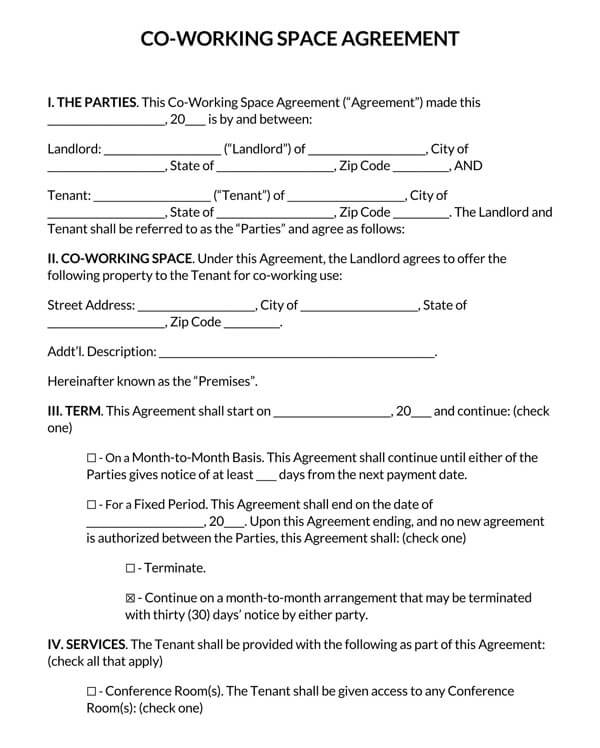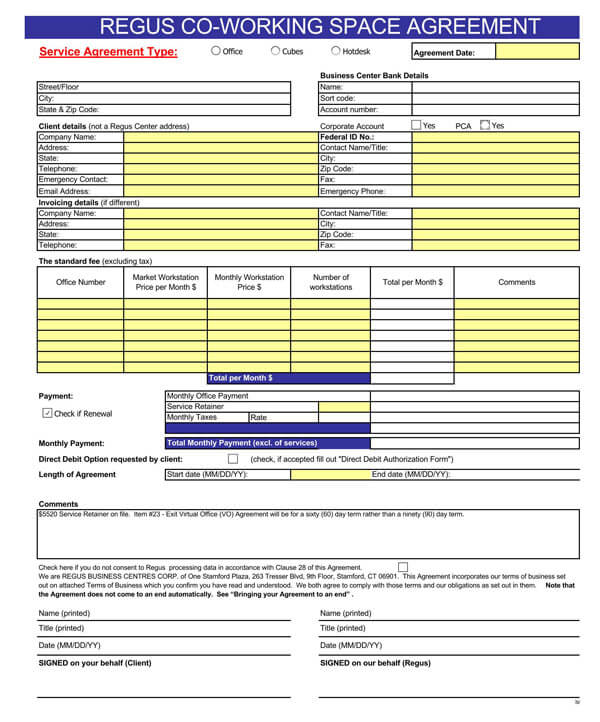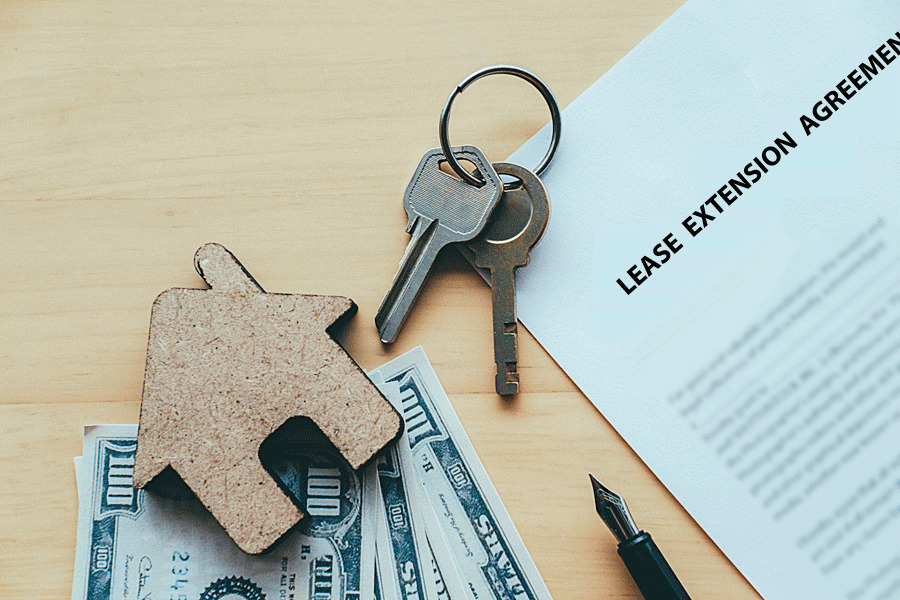The co-working lease agreement establishes the terms and conditions for using the leased space and defines the relationship between the parties involved.
By definition:
A co-working space lease agreement, also referred to as a shared or dedicated space lease agreement, is between a co-working business owner or a tenant, a business owner leasing part of his/her personal working space, and a person looking to lease the space (the tenant).
These spaces are usually used by people looking for flexibility, i.e., remote workers, those working on a budget, and startups looking for collaborative workplaces. These spaces allow professionals from different industries to come together without requiring any standard lease commitment. In addition, such spaces usually offer a suite of office-like amenities such as private meeting rooms, kitchens, coffee rooms, etc.
Co-working is gaining more popularity because a state’s real estate commission does not regulate such lease agreements because they don’t have the longer contract aspects and have no upfront costs that usually accompany the standard lease agreement.
For both parties involved, it involves far less risk compared to a traditional lease, whereby if either party defaults on the agreement, they have the liberty to leave the space without having to draw out a long, costly legal process. This makes it more suitable for anyone looking for flexibility and pocket-friendly spaces to work from.
Alternate names for a co-working lease agreement include:
- Co-op office space
- Shared office space
- Flexible office
- Serviced office space
- Flexible workspace
- Distributed workspace
Free Templates


Types of Co-Working Spaces
Regardless of the company’s size (large/small enterprise, startup, or corporate), a common denominator is flexibility. With flexible terms and conditions for use, custom buildouts, and an appealing list of amenities, there is always a co-working space available for every need and occasion.
Below are the different types of spaces that one may come across when looking for a shared space to work in:
Common area
Common area co-working, also referred to as open co-working, allows tenants low-level access to the workplace. Such areas permit access to the common areas, usually comprising tables and a plug for computers. In addition, the tenant is usually given access to other amenities such as conference rooms, internet, a business address, coffee, a kitchen, and any other amenities offered and/or agreed upon when signing the lease agreement.
note
In a common area, one is not usually allowed to leave any of their personal property. By signing this agreement, the tenant waives their right to sue the original tenant or owner of the premises for their lost items.
Dedicated workspace
In a dedicated workspace, a tenant usually leases a dedicated desk and chair within the leased space. The tenant has to renew the membership as agreed upon in the shared or dedicated lease agreement to secure the space. In dedicated workspaces, unlike in common area workspaces, the tenant has the liberty to leave their computers and any other personal property such as business files, chargers, etc. on their workspace as the space is more or less like their office, and they are guaranteed to use it as long as they make the required payments on time or as otherwise agreed on the lease agreement.
Dedicated office
The tenant is usually given access to an office space that is usually separated from other shared spaces in the workplace. Space in this type of lease agreement is usually defined by square footage and is usually only accessible to the tenant. Like any other office, such spaces can only be accessed using a key or card, made available to only the tenant upon signing the lease agreement.
Again, just like in the common area and dedicated workspace co-working lease agreements, the tenant has to remit their payments as agreed upon in the agreement to secure the office space.
Co-Working Lease Plans
There are different types of shared space lease agreements, offering tenants different styles of work.
Some of the most commonly used types include:
Hourly rate
The hourly rate permits usage of the leased space on an hourly basis, and the billing is based on the number of hours spent working by the tenant on the premises, i.e., check-in and check-out times.
Monthly membership
The monthly membership involves using a co-working space monthly, and billing is done every month to renew the membership. In addition, monthly membership includes social amenities such as common areas and dedicated office spaces.
By square footage
In a co-working space lease agreement by square footage, each member is given a space based on square footage, and the lease includes the use of social amenities such as common areas and a dedicated workspace billed every month.
Advantages of Co-Working
There are several benefits to co-working due to which individuals opt for this type of setting to rent in order to perform their official tasks.
Some of the major benefits include:
- Flexibility: Co-working offers flexibility, especially for people doing short-term group projects. Rather than leasing an office to operate from, they can choose a monthly membership and only work from there when they have work to do.
- Motivation: When surrounded by people striving to complete their projects, the energy of productivity in the air motivates people to also strive to complete more work.
- Networking: It becomes much easier for people working in the same space to network.
Conclusion
Although co-working differs from a customary office setup in many ways, it is increasingly gaining popularity, especially with SMEs, freelancers, corporations, and other businesses looking for financial flexibility and collaborative workspaces. When leasing out a co-working space, it is vital for a tenant to seek the premise owner’s consent if such provisions are not initially included in the original lease agreement. Also, it is essential to establish the rules of engagement with the tenants by using a lease agreement to ensure that the terms and conditions for using the premises are well defined.











